Miele W 820 User Manual

Operating Instructions
for washing machine W 820
It is essential to read these operating instructions before installing or using the machine to avoid the risk of accident, or damage to the machine.
Q
M.-Nr. 04580320

Contents
Page
Guide to the machine. . . . . . . . . . . . . . . . . . . . . . . . . . . . . . . . . . . . . . . . . . . . . . . . 3 Caring for the environment. . . . . . . . . . . . . . . . . . . . . . . . . . . . . . . . . . . . . . . . . . . . 5 Before using for the first time . . . . . . . . . . . . . . . . . . . . . . . . . . . . . . . . . . . . . . . . . . 6 Warning and Safety Instructions . . . . . . . . . . . . . . . . . . . . . . . . . . . . . . . . . . . . . . . 7 Preparing the wash load . . . . . . . . . . . . . . . . . . . . . . . . . . . . . . . . . . . . . . . . . . . . . 9 Wash care symbols . . . . . . . . . . . . . . . . . . . . . . . . . . . . . . . . . . . . . . . . . . . . . . . . 10 Adding detergent. . . . . . . . . . . . . . . . . . . . . . . . . . . . . . . . . . . . . . . . . . . . . . . . . . 11 Adding fabric conditioner/starch . . . . . . . . . . . . . . . . . . . . . . . . . . . . . . . . . . . . . . 12 Programme selection . . . . . . . . . . . . . . . . . . . . . . . . . . . . . . . . . . . . . . . . . . . . . . . 13 Changing a programme sequence . . . . . . . . . . . . . . . . . . . . . . . . . . . . . . . . . . . . 14 Programmes. . . . . . . . . . . . . . . . . . . . . . . . . . . . . . . . . . . . . . . . . . . . . . . . . . . . . . 15 Programmable functions . . . . . . . . . . . . . . . . . . . . . . . . . . . . . . . . . . . . . . . . . . . . 18 After washing . . . . . . . . . . . . . . . . . . . . . . . . . . . . . . . . . . . . . . . . . . . . . . . . . . . . . 21 Cleaning and care . . . . . . . . . . . . . . . . . . . . . . . . . . . . . . . . . . . . . . . . . . . . . . . . . 22 Problem solving guide . . . . . . . . . . . . . . . . . . . . . . . . . . . . . . . . . . . . . . . . . . . . . . 26 After sales service . . . . . . . . . . . . . . . . . . . . . . . . . . . . . . . . . . . . . . . . . . . . . . . . . 30 Installation . . . . . . . . . . . . . . . . . . . . . . . . . . . . . . . . . . . . . . . . . . . . . . . . . . . . . . . 31 Electrical connection . . . . . . . . . . . . . . . . . . . . . . . . . . . . . . . . . . . . . . . . . . . . . . . 34 Plumbing . . . . . . . . . . . . . . . . . . . . . . . . . . . . . . . . . . . . . . . . . . . . . . . . . . . . . . . . 36 Technical data . . . . . . . . . . . . . . . . . . . . . . . . . . . . . . . . . . . . . . . . . . . . . . . . . . . . 38
Help to protect our environment
Disposal of the packing material
The transport and protective packing is mostly manufactured from the following reuseable materials:
–Corrugated paper / card
–Polystyrene - CFC free
–Polyethylene foil (transparent)
–Fibre board - solvent free
–Wood - untreated
–Packaging straps: Polyamide (blue)
Polypropylene (black)
Rather than just throwing these materials away, please take them to the nearest local authority collection point for specific waste.
Disposal of your old machine
Old machines contain materials which can be recycled. Please contact your local authorities or scrap merchant about potential recycling schemes, before disposing of the appliance.
2
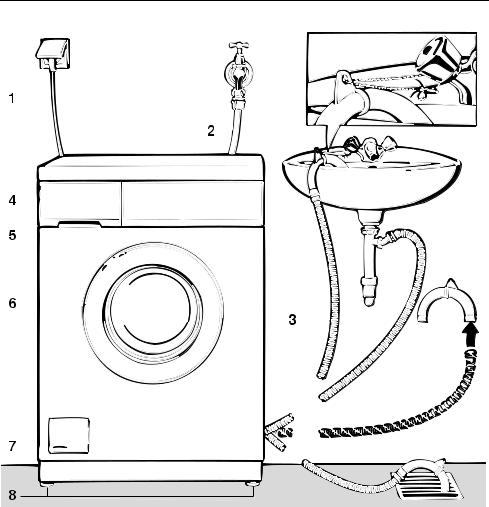
Guide to the machine
|
|
|
|
|
|
|
|
|
|
|
|
|
|
|
|
|
|
|
|
|
|
|
|
|
|
|
|
|
|
|
|
|
|
|
|
|
|
|
|
|
|
|
|
|
|
|
|
|
|
|
|
|
|
|
|
|
|
|
|
|
|
|
|
|
|
|
|
|
|
|
|
|
|
|
|
|
|
|
|
|
|
|
|
|
|
|
|
|
|
|
|
|
|
|
|
|
|
|
|
|
|
|
|
|
|
|
|
|
|
|
|
|
|
|
|
|
|
|
|
|
|
|
|
|
|
|
|
|
|
|
|
|
|
|
|
|
|
|
|
1 |
Supply cable |
6 |
Drum door |
||||||||||
2 |
Inlet hose (able to withstand press |
7 |
Access panel - drain pump and fil- |
||||||||||
|
|
ures up to 70 bar) |
|
ter, emergency door opener |
|||||||||
3 |
Flexible drain hose, with detachable |
8 |
Four height adjustable feet |
||||||||||
|
|
swivel elbow |
|
|
|
|
|
||||||
4Detergent dispenser drawer
5Facia panel with controls
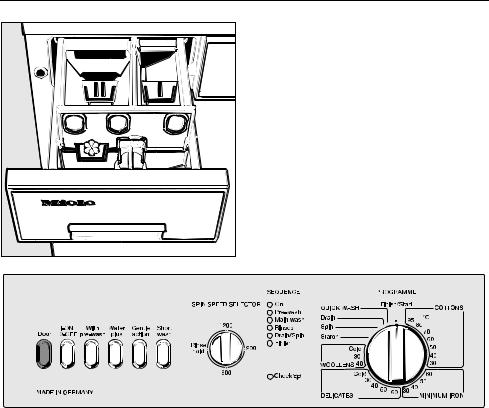
Guide to the machine
Button “Door” opens the drum door
Button “On/Off”
to switch on or off or interrupt a programme Light “On” illuminates
Pushbutton switches for additional functions
Detergent dispenser drawer
Compartment i - for the pre-wash
Compartment j - for the main wash
Compartment p (with extra lid) - for fabric conditioner or liquid starch formulation
Spin speed selector
Programme sequence indicator
(LED indicator lights)
Programme selector switch
4

Caring for the environment
Caring for the environment
Caring for the environment means saving water, energy and detergent when washing. This machine is equipped with the Hydromatic System and the Ball Valve for economical use of resources. These systems offer a variety of technical innovations e.g. the drum ribs, which are designed to enable economical washing without compromising on results.
The automatic load control facility enables loads of between 1 and 5 kg to be washed using only as much water and electricity as is required for an effective wash.
Spinning at the high speed of
1200 rpm reduces drying times and energy consumption if laundry is dried in a tumble dryer after washing.
Economy tips
To help you wash most economically, remember the following tips:
Always wash with the maximum laundry load specified for each programme. This uses the energy to the best advantage.
Only use the correct amount of detergent required for the water hardness level in your area, as recommended by the manufacturer.
If laundry is not heavily stained, select a lower temperature setting than indicated on the laundry care label (but when using a lower temperature do not select the “short”-option).
Lightly soiled laundry can be washed using a “short”-programme (additional temperature reduction not recommended).
5
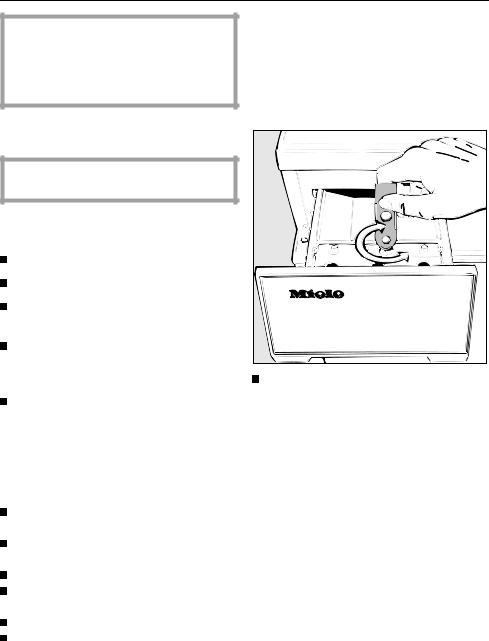
Before using for the first time
Important:
the appliance must be properly installed and connected to the water and electricity supply according to local and national regulations.
For further information read the instructions on pages 31 - 37
Check that the transit fitting at the rear has been removed.
Before using for the first time prime the ball valve as follows:
Switch on the machine.
Turn the selector switch to “Starch”.
Once the drum starts turning: set the programme selector to “Drain”.
When the water has drained: turn the programme selector to the “Finish/Start” position.
Switch the machine off.
The ball valve is operational.
Any residual lubricants and water from testing still in the machine should be flushed out as follows:
Do not load any laundry in the machine.
Add a little detergent to compartment j.
Switch on the machine.
Turn the programme selector switch to the “Cottons 60°C” programme. Press the “Short” button.
The residues will have been flushed out once the programme has finished.
Water hardness reminder.
The amount of detergent will depend on various factors including the water hardness level in your area. Set the water hardness dial located in the detergent dispenser box as a reminder.
Turn the dial to the required setting. Use the spatula supplied with the machine. It is located at the rear of the dispenser drawer facia (see page 23).
If you do not know how hard the water is in your catchment area, please contact your local water authority.
Water hardness
Hardness |
water |
mg/litre |
Clake’s |
°dH |
range |
|
|
scale |
(German) |
|
|
|
|
|
1 |
soft |
up to 135 |
up to 10° |
0-7° |
|
|
|
|
|
2 |
medium |
up to 250 |
10°-20° |
7°-14° |
|
|
|
|
|
3 |
hard |
up to 380 |
20°-25° |
14°-21° |
|
|
|
|
|
4 |
very hard |
over 380 |
over 25° |
over 21° |
|
|
|
|
|
6

Warning and Safety Instructions
This appliance is designed and intended only for normal household use in the U.K. It should never be operated by children. Supervise its use by the elderly or infirm.
Read the operating instructions through before using this machine for the first time, as this is for your safety and the protection of the machine. They give notes on the safety, the use and the maintenance of the machine.
Further warning and safety instructions are given in the text as appropriate.
...before using for the first time
Do not install your washing machine in rooms where sub-zero temperatures may occur. Frozen hoses
may burst under pressure.
The reliability of the electronic control system may be impaired at temperatures below freezing point.
Before using the machine for the first time, check that the transit fit-
ting at the rear of the machine has been removed (see page 31). During spinning, a transit fitting which
is still in position may result in damage to both the machine and adjacent furniture or appliances.
If the drain hose is attached to a wash basin or sink, make sure it is
secure, (see illustration in the section“Guide to the machine”),
so that the force of the water flowing out of the hose does not dislodge it, as this will otherwise result in flooding.
If hooking the hose into a wash basin, check that the water can drain off
quickly enough to prevent the sink from overflowing.
Keep these operating instructions in a safe place.
...when using your machine
Only wash items which are declared by the manufacturer to be
machine-washable on the care label (textile care G.B. laundry care, AUS), (see Care labels on page 10).
Descaling agents contain acid. Only use proprietary non-corrosive
descaling agents and strictly observe the manufacturer’s instructions. After descaling, always run several full rinse cycles to remove any acid residue and to protect component parts from corrosion.
Never use detergents containing solvents in this machine, as this may result in damage to component
parts and create toxic fumes. Such detergents also pose a fire and explosion hazard.
Textiles which have been pretreated in detergents containing
solvents must be thoroughly rinsed in clean water before being washed in this machine.
Do not use dye removers as these contain sulphur compounds which
may damage washing machines.
7

Warning and Safety Instructions
Dyes must be specified as suitable for use in washing machines. Al-
ways observe the manufacturer’s instructions.
If washing at very high temperatures remember that the porthole
glass will be hot.
Do not let children touch it during a wash programme.
The machine should only be operated unsupervised if there is a floor
drain in the immediate vicinity.
The best materials are used in the manufacture of this machine, and every care is taken to check all parts.
However, with time, deterioration of parts can occur, especially with such components as hoses, giving rise to leaks. This should be borne in mind if operating the machine without supervision. Check the hose regularly for signs of wear, and change in good time, to avoid leaks and subsequent damage.
Always make sure the drum is stationary before reaching in to
remove washing. Reaching into a moving drum is extremely dangerous.
Foreign objects (e.g. nails, coins, paper clips etc.) can cause damage to textiles and components in the
machine. Take care to empty all pockets etc. so that these do not go into the machine.
...in the event of faults
Electrical appliances should only be repaired by suitably competent
personnel. Incorrectly repaired machines may pose a considerable risk to the user.
Disconnect the machine from the mains power supply by switching
off at the wall socket, unplugging, or withdrawing the mains fuse.
8
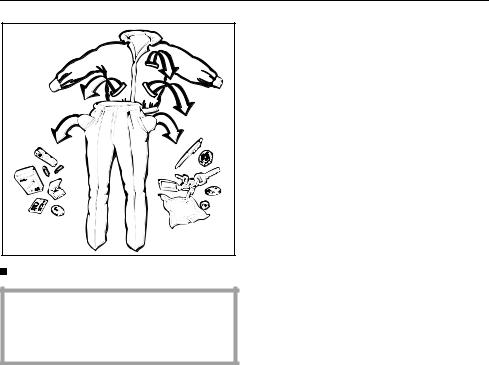
Preparing the wash load
Empty all pockets.
Foreign objects (e.g. nails, coins, paper clips etc.) can cause damage to textiles and components in the machine.
Sort the laundry
Most garments have a textile care label in the collar or side seam. Sort the laundry by care label symbols.
Only wash items in this machine which are declared by the manufacturer as being machine washable on the textile care label.
Dark textiles often contain“excess dye,” and should be washed separately several times before being included in a mixed load.
Delicate textiles should be washed separately in a delicates programme.
Only wash textiles made from wool or wool mixtures if they are declared as being suitable for machine washing on the textile care label.
Pre-treating the washing
Badly soiled areas, e.g. collars and cuffs, and water soluble stains, can be pre-treated with bar soap, liquid detergent or detergent mixed into a solution or paste.
With particularly stubborn stains ask your Dry Cleaner for advice.
Do not use detergents containing solvents in this machine.
Loading the drum
Unfold laundry and load loosely in the drum. To achieve best results it is advisable to make up mixed loads consisting of both large and small items. This improves the washing effect and helps distribute the load evenly to keep the machine stable and reduce the noise level during spinning.
It is advisable to weigh the load first to make best use of the machine’s capacity.
Maximum load weights are noted below:
COTTONS . . . . . . . . . . . . . . . . . . 5.0 kg MINIMUM IRON . . . . . . . . . . . . . 2.5 kg DELICATES/SYNTHETICS . . . . . 1.0 kg WOOL . . . . . . . . . . . . . . . . . . . . . 1.0 kg QUICK WASH . . . . . . . . . . . . . . . 2.5 kg
With curtains: Remove lead weights and strips or place in a laundry bag. Woollens and knitted garments should be turned inside out if the manufacturer recommends it.
Close the drum door
Make sure that there is no obstruction between the drum door and seal.
9
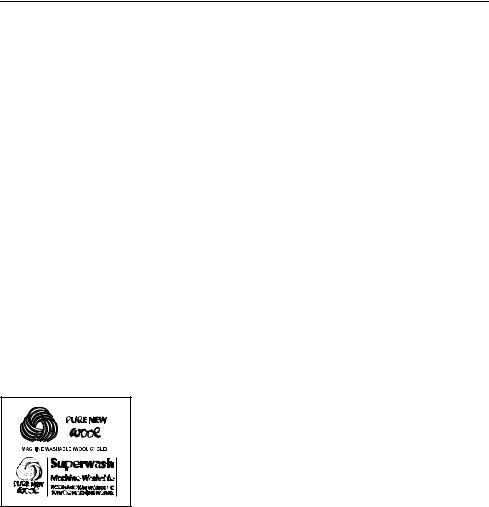
Textile care symbols
Washing
987 Cottons
4321 Minimum iron
a@ Delicates, Wool
The significance of the bar beneath the wash tub:
no bar |
normal (maximum) agitation |
eeg Cottons programme
bar |
reduced (medium) agitation, |
feg Minimum iron programme + Gentle action, or Delicates programme.
broken |
much reduced (minimum) |
bar |
agitation, Woollens |
g |
programme |
Machine washable woollens
Use the special “Wool” programme, and only wash woollens bearing the label shown here:
This symbol is registered by the IWS (International Wool Secretariat).
/Hand wash
hdo not wash
ABC dry clean
Ddo not dry clean
ysuitable for chlorine bleaching
znot suitable for chlorine bleaching
Tumble dry
qat normal temperature
rat the lower temperature
sdo not tumble dry
Ironing
Ihot iron
Hmedium hot iron
Gcool iron
Jdo not iron
N.B. If you have any textiles with the older wash care labels, select a programme according to the table below.
[:] Cottons
?;\ Minimum iron
={ Delicates
#Woollens
10

Adding detergent
All modern detergents produced for automatic washing machines are suitable, including liquid, compact (concentrated) and special application detergents. Use dispensing aids e.g. balls if these are supplied with the detergent. Woollens and knitware containing wool mixtures should be washed using a detergent specifically designed for washing woollens.
Add the right amount of detergent as recommended on the packaging The amount dispensed will depend on the following:
–the quantity of laundry
–the water hardness level
–the level of soiling
It is important to dispense the cor-
rect amount, because...
...too little detergent results in the following:
–The laundry will not get properly clean and will in time become grey and hard to the touch.
–Greasy particles cling to the laundry.
–Lime deposits on the heater elements.
...too much detergent results in the following:
–Excessive foam.
–Low level of agitation.
–Poor washing and rinsing results.
Water is taken in through compartment j in the main wash. If the capacity of compartment j is insufficient for the amount of detergent needed where water hardness is above 380 mg/l (in hardness area 4), the Customer Service Engineer can adjust the machine so that water can also be taken in through compartment i to take detergent into the main wash.
Water Softeners
A water softener can be used to cut down on the use of detergents in water hardness ranges 2 - 4. Dispense according to the amount specified on the packaging. First add detergent and then the water softener. Detergent can be dosed as for water hardness range 1.
We recommend: if you wash using several components (e.g. special application detergents), dispense the agents in the following order into compartment j :
1.Detergent
2.Water softener
3.Stain salts
This way the agents are distributed better.
11
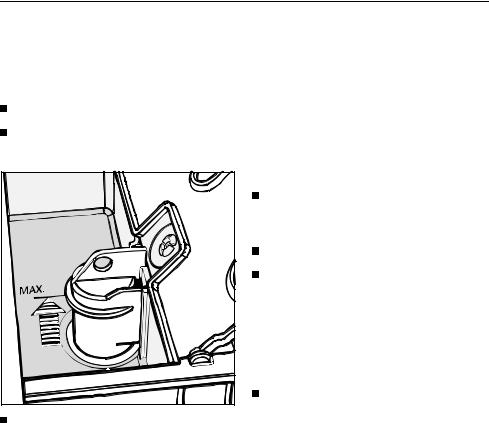
Fabric conditioners / starch formulations
Fabric conditioners make garments soft and fluffy to handle and help prevent static cling when tumble drying. Dispense according to the manufacturer’s recommendations.
Open the lid of compartment p .
Add fabric conditioner, but do not exceed the max. level.
Close the compartment lid and push in the dispenser drawer.
The conditioner is automatically dispensed in the last rinse. At the end of the programme a small amount of water remains in the fabric conditioner compartment.
Texturiser and liquid starch formulations
These synthetic starch formulations give body to items e.g. shirts, tablecloths and bed linen. Add starch formulations to the fabric conditioner compartment following the same procedure as for fabric conditioner.
Powder starch
Prepare and dispense the starch solution in accordance with the manufacturer’s instructions.
Add to compartment i .
Turn the programme selector switch to the “Starch” position.
If preferred select “rinse hold” to prevent creasing. The laundry remains suspended in the last rinse water.
To continue the programme:
Select “Drain” or “Spin”.
12
